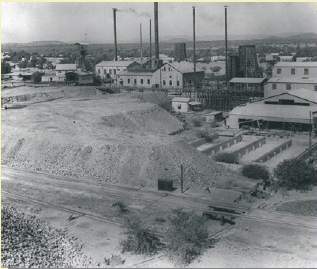Deutsch Südwestafrika
German colony from 1884 to 1919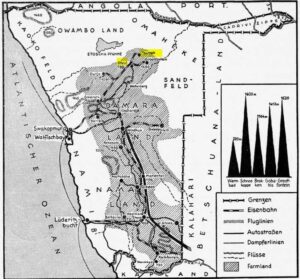
From 1884 to 1915, Deutsch-Südwestafrika was a German colony in the area of the today’s State of Namibia. With a surface of 835.100 km ² Deutsch-Südwestafrika was approximately 1.5 times as large as the German Kaiserreich at that time. Deutsch-Südwestafrika was the only German coloniy, in which a purposeful settlement of Germans took place in larger style. Apart from the exploitation of diamonds and copper, particular cattle breeding lured in German settlers. In 1902, the colony had approx. 200,000 inhabitants, under it 2,595 Germans. Until 1914, further 9,000 German settlers came. In the context of the First World War in 1915, the area was conquered and then 1919 transferred under the administration of South Africa. Only since 1990 Namibia is independent.
German appropriation
Originally, the country was inhabited by shrub men. In the second half of the 18. century took place from northeast the immigration of the Hereros and from the south those the Hottentotten. The name “Hottentotten” (Stotterer) derives from a name of Dutch settlers for the people of the Nama, the peculiar language because of. They call themselves as Khoi Khoi (true humans) or as Nama – after its settlement area Namaqualand. The martial trunks of the immigrants it succeeded to subjugate fast the original inhabitants of the country and partly exterminate. Between the Hereros and the Namas it came in the future to wars for many decades.
On behalf of Bremen the merchant Adolf load-cut acquired Heinrich Vogelsang on 1 May 1883 of the Nama chieftain Fredericks II. for 200 old rifles and 100 English pound the bay of Angra Pequena, the today’s charge cutting bay, with five miles hinterland. Vogelsang left open whether it around those the Nama admitted themselves of English miles or the five times longer German miles act should. There load-cut later from the German unit proceeded, the Namas were deceptive. The acquired area was placed 1884 under the protection of the German Reich, in order to secure the land acquisitions against British territorial claims.
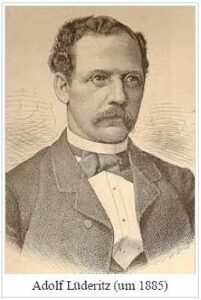
In the same month Vogelsang concluded a second contract, in load-cuts the Küsttenstreifen between the Oranje river and that 26. Degree of latitude and an area were sold by 20 miles landinward of each point of the coast out for further 500 pound and 60 rifles. 1885 were furnished in Otjimbingwe the first administrative seat. 1890 became larger German southwest Africa around the Caprivizipfel in the northeast, from which one promised oneself new commercial routes, and which manufactured the connection to the Sambesi river. In same year the foundation-stone for the celebrations was put „largely Windhuk “, to the today’s state capital “Windhoek”.
Economy and infrastructure
The first German settlers concerned themselves mainly with the cattle industry. After in the north copper and in the south diamonds were found later, also an industrial infrastructure developed. The building of the first railroad line Swakopmund Windhoek was begun 1897 and finished 1902. Further railway connections in the south and the north of the country followed; thus of load-cut after and Keetmanshoop, from Keetmanshoop to Windhuk, as well as into the copper extraction area of the Otavibergland. Thus German southwest Africa had the most extensive route network of all German colonies. It had a length of 2.100 km with outbreak of the First World War. The railway network had a crucial portion of the ascent of the country. The early, by the state supported attempt to open with truck the country brought with no success, since these were stuck in the desert sand. A regular shipping connection with Germany took place starting from 1898.
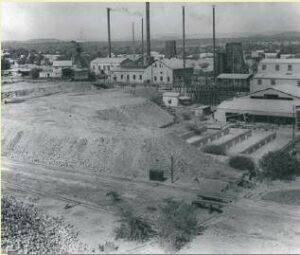 Although expectation was not unfounded to find in the desert country valuable minerals, as number-lined finds up to South Africa had pointed, proved – in particular which concerned gold – none of stores as worthy of exploitation. On the other hand, although in the long term, high-quality marble occurrences promised profit. Same was valid for the coal discovered with Keetmanshoop. However the numerous copper ore camps, which were found in all parts of the country and from those since over 400 years ores had been partly already reduced, played the largest role. Around 1850 a proper “copper intoxication” began, when the message had gotten around itself over rich occurrences in the central and southern Namibia. The societies Walvis Bay Mining company and Great Namaqua Mining company were created. Also the natives of the Otaviberglandes had reduced and had smelted for a long time ore, had however kept the place secret Tsumeb. Only 1893 were already finished ore-broke off discovered and the worthy of exploitationness festgestelltIm an August 1900 met the first expedition in Tsumeb and 1906 the railway line between Swakopmund and Tsumeb and the dismantling of the ore began. No mineral place of discovery reached the fascination of Tsumeb during a so long period. The occurrence of gallium and germanium, the size of the crystals made Tsumeb world-famous. In the course of the years the Otavi mines and railway company acquired further ore camps, so that in the Otavi mines 1907/08 25,000 t, 1909/10 nearly 50,000 t could be promoted. „To the regular study of the country “by several German large firms “the Southwest African mine syndicate was created”, which maintained a mountain-technical laboratory in Swakopmund and its efforts on the development of further more valuable, enrich copper ore occurrences concentrated. For good reason: Of Germany portion of the world production only 3.5% amounted to, its need however were 23%, which meant an economic dependence.
Although expectation was not unfounded to find in the desert country valuable minerals, as number-lined finds up to South Africa had pointed, proved – in particular which concerned gold – none of stores as worthy of exploitation. On the other hand, although in the long term, high-quality marble occurrences promised profit. Same was valid for the coal discovered with Keetmanshoop. However the numerous copper ore camps, which were found in all parts of the country and from those since over 400 years ores had been partly already reduced, played the largest role. Around 1850 a proper “copper intoxication” began, when the message had gotten around itself over rich occurrences in the central and southern Namibia. The societies Walvis Bay Mining company and Great Namaqua Mining company were created. Also the natives of the Otaviberglandes had reduced and had smelted for a long time ore, had however kept the place secret Tsumeb. Only 1893 were already finished ore-broke off discovered and the worthy of exploitationness festgestelltIm an August 1900 met the first expedition in Tsumeb and 1906 the railway line between Swakopmund and Tsumeb and the dismantling of the ore began. No mineral place of discovery reached the fascination of Tsumeb during a so long period. The occurrence of gallium and germanium, the size of the crystals made Tsumeb world-famous. In the course of the years the Otavi mines and railway company acquired further ore camps, so that in the Otavi mines 1907/08 25,000 t, 1909/10 nearly 50,000 t could be promoted. „To the regular study of the country “by several German large firms “the Southwest African mine syndicate was created”, which maintained a mountain-technical laboratory in Swakopmund and its efforts on the development of further more valuable, enrich copper ore occurrences concentrated. For good reason: Of Germany portion of the world production only 3.5% amounted to, its need however were 23%, which meant an economic dependence.
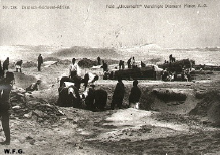
In the summer 1908 a distance worker of the railway construction behind charge cutting bay in the gravelly sand found „a glittering little stone “, which he recognized as diamond, it in former times in a South African diamond mine had nevertheless worked. Its master rich people became over night. Over Finderlohn is nothing admits become. Already soon jederman in the charge cutting bay of the diamond fever, the race was packed around possession portions began. Already after three months diamonds had been found of altogether 2,720 carat, up to the end of the year amounted to the value of the promotion already 1.1 million Reichsmark. Up to the outbreak of the First World War diamonds were promoted in the value of 152 million Reichsmark. On the diamond fields prevailed immediately chaotic conditions, law cases and illegal diamond dismantling prepared for the German government large concerns. Finally the German state wanted to receive as large a portion of this wealth as possible and explained from there in September 1908 the area between Oranje river in the south and that to 26. For degree of latitude in the north as well as line is enough for 100 km landinward to the restricted area and assigned the prospecting license to the German colonization and administration company for colonies, which had been created 1885, in order to enlist farm country to he and Sielder. Substantial other areas were in the possession of the treasury, the colonial mining company and the Colmanskop Diamond Ltd. Starting from 1912 the diamond promotion with a tax was occupied by 6,6%, whereby annually about 10 million Reichsmark flowed to the colonial administration.
Also today the diamonds from Namibia are still because of their high decoration quality the most wanted jewels of the world. Thus the diamond mining industry until today is one of the most important economic factors for Namibia.
Altogether seen, however the German colonies were an economic losing transaction. The scope of supply of the products, which one imported from the colonies into the German Reich, covered usually only a very small part of the domestic demand. Apart from copper and diamond from German southwest Africa the colonies did not form economic situation support, however high sums devoured for the colonial administration and striking down of riots. Private-economically seen investors could however, apart from whom high investments at the beginning, large profits register.
Colonial administration

After load-cut the German government of the economic importance of his address into southwest Africa had convinced and for sovereign protection had asked, 1884 became an imperial Consul General and commissioner for west Africa appointed, meanwhile the administration first in the hands of commercial societies to lie should.
Further it came to a multiplicity of collisions between the different master groups and also the German settlers. Again and again the governors of the colony with partly drastic means had to proceed against the native ones. In the year 1904 it came to the so-called Herero rebellion, which was based on that the ethnic group saw itself to more toward substantial land purchases of the German colonization and administration company for colonies ever from its settlement area back-pushed and toward unscrupulous dealers to the edge of the economic ruin brought. Farms, railway lines and commercial stations were attacked. The German security forces which were subject in terms of figures were strengthened by 500 marines and a volunteer troop, yet it did not succeed first to achieve crucial advantages. The realm government appointed thereupon the lieutenant general von Trotha to the new commander in chief of the security forces. This pursued the goal of the complete destruction of the opponent. He let come again reinforcement from Germany and placed the Hereros on 11 August 1904 to the decisive battle to wading hereditary suppl. It succeeded to the Hereros, as in case of a defeat planned to evade after southeast it underestimated however the difficulties, which wounded themselves by an escape with cattle and herds of goat, women, children and from the Omaheke Trockensavanne showed. During the fights and the escape died to different information of source up to 60% of the Hererovolkes.
In October 1904 then also the Nama in the south of the country rose. Followed wearing down a guerilla war for many years with the security forces, which only 1907/08 could be finally struck down. The procedures cost the life by diseases, hunger and thirst, fighting, escape and drawbacks often beneath human dignity in the internment camps according to estimation between 24.000 and 64.000 Herero, about 10,000 Nama as well as 1,365 settlers and soldiers.
By the rebellions the economy of German southwest Africa was come to succumbing, which had farm economy is completely again developed, it almost gave hardly still cattle. With compensations to the amount of altogether 7 million Reichsmark the realm government ensured for the fact that most farmers in the country could be held.
The First World War and the end of the colony
After in Europe on 1 August 1914 the First World War had broken out, one expected an attack of the South African union allied with Great Britain in German southwest Africa, therefore one proclaimed the mobilization on 8 August and evacuated 50 km a broad strip along the border to South Africa. It turned out fast that the German security forces had hopelessly been subject to the South Africans. On 9 July 1915 the governor signed an explanation over the delivery of the German security forces to the South African union. About half of the German population of southwest Africa was sent back by July 1919 to Germany. The end of German southwest Africa was sealed with the Versailler contract from 28 June 1919.
